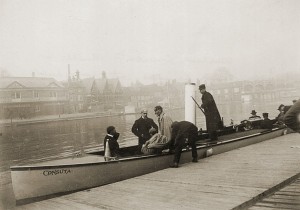 Its no secret that I have a bit of a passion for steam engines so when Andy Rawson suggested I give David Eager a call if I fancied going for a trip down the Thames on an 1890s steam boat I jumped at the chance but there was immediately a slight snag when I found out the date. I was booked to assist with a run through of a project we have been working on from which I couldn’t escape so it just wasn’t going to happen unless I went into hiding, faked an unexpected illness or engineered to get away early so I had to, extremely reluctantly, decline. “Don’t worry, we’re moving it downriver towards the end of the month to Hobbs Yard at Henley so it can be lifted out for the winter, I’m sure there’ll be room on board then if you’re interested” he explained, and that was that. Arrangements had already been made for the weekend of the 5th and 6th October in so far that I had a couple of examination flights booked but this time, for a change, I put the candidates on standby. The weather was looking good and a mail arrived to say it was on for the Saturday. I moved the flights to Sunday and the other Monday and set the alarm for silly o’clock.
Its no secret that I have a bit of a passion for steam engines so when Andy Rawson suggested I give David Eager a call if I fancied going for a trip down the Thames on an 1890s steam boat I jumped at the chance but there was immediately a slight snag when I found out the date. I was booked to assist with a run through of a project we have been working on from which I couldn’t escape so it just wasn’t going to happen unless I went into hiding, faked an unexpected illness or engineered to get away early so I had to, extremely reluctantly, decline. “Don’t worry, we’re moving it downriver towards the end of the month to Hobbs Yard at Henley so it can be lifted out for the winter, I’m sure there’ll be room on board then if you’re interested” he explained, and that was that. Arrangements had already been made for the weekend of the 5th and 6th October in so far that I had a couple of examination flights booked but this time, for a change, I put the candidates on standby. The weather was looking good and a mail arrived to say it was on for the Saturday. I moved the flights to Sunday and the other Monday and set the alarm for silly o’clock.
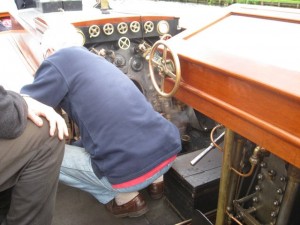 Now what you have to understand is that steam 1890s style means preparation. No turn-key here. Lighting of the boiler was planned for 7.30 with the intention of getting away about nine. Departure was from Beale Park near Pangbourne and I was there good and early but having strolled down to the Thames there wasn’t a sign of anyone or anything. This was strange and not helped by a gentle mistiness. I wandered back to the pickup, tipped out most of the cab and eventually found the phone. Turned out they were on a lake up the other end of the carpark. Mr Eager was just the same, all smiles, pleasantness and warm greetings. He flew with us in the old Flying Pictures days mainly at the bigger balloon meets and was also a Category 1 inspector in the days when the BBAC Technical Office were responsible for mods and approvals. He hadn’t flown a balloon for years and reckoned if balloonists had discovered steam first that’s what they’d have done. I tended to agree with him. His neighbour Nigel Gourley turned out to be a retired VC10 flight engineer who had almost certainly flown with my uncle and was now the official diver as the large prop on Consuta was prone to collecting old chains and bits of rope from time to time. The day was boding well.
Now what you have to understand is that steam 1890s style means preparation. No turn-key here. Lighting of the boiler was planned for 7.30 with the intention of getting away about nine. Departure was from Beale Park near Pangbourne and I was there good and early but having strolled down to the Thames there wasn’t a sign of anyone or anything. This was strange and not helped by a gentle mistiness. I wandered back to the pickup, tipped out most of the cab and eventually found the phone. Turned out they were on a lake up the other end of the carpark. Mr Eager was just the same, all smiles, pleasantness and warm greetings. He flew with us in the old Flying Pictures days mainly at the bigger balloon meets and was also a Category 1 inspector in the days when the BBAC Technical Office were responsible for mods and approvals. He hadn’t flown a balloon for years and reckoned if balloonists had discovered steam first that’s what they’d have done. I tended to agree with him. His neighbour Nigel Gourley turned out to be a retired VC10 flight engineer who had almost certainly flown with my uncle and was now the official diver as the large prop on Consuta was prone to collecting old chains and bits of rope from time to time. The day was boding well.
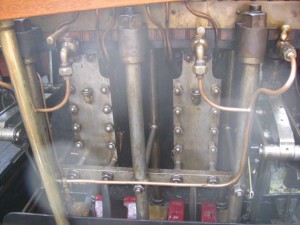 The Consuta was not quite what I had imagined, well not its length. At 52 foot its technically a ship and is accordingly on the historic ship register but in reality it is a big kayak with a boiler and steam engine in the middle. I would have called her a launch. She sat quietly just starting to warm up alongside a semi-floating jetty her fire being fed bits of wood collected from the local woodland awaiting the first shovel full of coal. The steam engine was a twin cylinder double-acting type, something I recognised but wasn’t familiar with, the Stephenson links that effectively reverses the engine was though. With this type of engine the steam is applied alternatively above and below the piston so it is both driven up and down so no stroke is wasted making it very responsive and reckoned to be good for 100hp. The boiler is a typical small steam locomotive type with a working pressure of 150psi and built in 1985. This is heavy for Consuta and not really up to the job but, fear not, David has already spent over 400 hours researching steam engine boilers and has designed a superior, much lighter one that they hope to build next year.
The Consuta was not quite what I had imagined, well not its length. At 52 foot its technically a ship and is accordingly on the historic ship register but in reality it is a big kayak with a boiler and steam engine in the middle. I would have called her a launch. She sat quietly just starting to warm up alongside a semi-floating jetty her fire being fed bits of wood collected from the local woodland awaiting the first shovel full of coal. The steam engine was a twin cylinder double-acting type, something I recognised but wasn’t familiar with, the Stephenson links that effectively reverses the engine was though. With this type of engine the steam is applied alternatively above and below the piston so it is both driven up and down so no stroke is wasted making it very responsive and reckoned to be good for 100hp. The boiler is a typical small steam locomotive type with a working pressure of 150psi and built in 1985. This is heavy for Consuta and not really up to the job but, fear not, David has already spent over 400 hours researching steam engine boilers and has designed a superior, much lighter one that they hope to build next year. 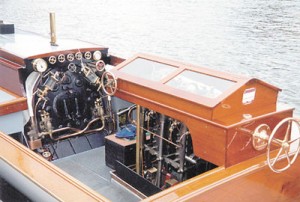 This will get the lovely launch back to nearer its original weight of three tons and make it sit higher in the water and thus faster which I was assured it already is. During trials back in 1898 it reached 27½ mph, almost three times the speed limit on the Thames today but well up with the rowing teams and with far less wash than modern speedboats or umpire launches. If they got a chance they’d open it up a bit I was told amidst broad grins. This is one fantastical launch which was now starting to quietly rumble, clunk and gurgle as the boiler came to life in the way only steam engines do. A healthy smog was now coming out the funnel and the pressure needle started to creep up. The valves to the engine were partially opened and the engine bled up then allowed to gently rotate, not too much as the drive to the prop is direct, but just enough steam to warm it through. She was alive and moving, whisps of steam coming from here and there.
This will get the lovely launch back to nearer its original weight of three tons and make it sit higher in the water and thus faster which I was assured it already is. During trials back in 1898 it reached 27½ mph, almost three times the speed limit on the Thames today but well up with the rowing teams and with far less wash than modern speedboats or umpire launches. If they got a chance they’d open it up a bit I was told amidst broad grins. This is one fantastical launch which was now starting to quietly rumble, clunk and gurgle as the boiler came to life in the way only steam engines do. A healthy smog was now coming out the funnel and the pressure needle started to creep up. The valves to the engine were partially opened and the engine bled up then allowed to gently rotate, not too much as the drive to the prop is direct, but just enough steam to warm it through. She was alive and moving, whisps of steam coming from here and there.
Everything about steam power is a marvel really. Strangely people wax lyrical about their cars, even giving the things names, but unless you’ve had hands on with a steam engine you have no understanding of power or presence. The sound of a steam engine under power is awesome, at rest its silent. Its about as close as you get to a living thing. The principle is simple enough but keeping it all going, especially at full tilt boogey, is a full time job and a bit like patting your head and rubbing your tummy.  They’ll steam along quite happily for a while but any steam engine, and especially one this old, needs oiling and draining, watching and working with if it is to be operated reliably. Let the pressure drop or the oil run dry and it won’t go. You need to listen to it constantly, keep an eagle eye on water levels, the fire and pressure then attend to their needs accordingly. A crew of two is the minimum but we were spoilt as one was appointed to look after the boiler, one to work the engine and one on the rudder which was alarmingly small, I thought, for a craft of this length. Having taken up position in the stern so I could inhale the smoke and steam and get smuts in me eyes I watched in awe as the crew cast off and we headed through the swing bridge and out into the wide misty early morning Thames. There wasn’t a soul about save a Dutch-type cruiser who waved as they passed us.
They’ll steam along quite happily for a while but any steam engine, and especially one this old, needs oiling and draining, watching and working with if it is to be operated reliably. Let the pressure drop or the oil run dry and it won’t go. You need to listen to it constantly, keep an eagle eye on water levels, the fire and pressure then attend to their needs accordingly. A crew of two is the minimum but we were spoilt as one was appointed to look after the boiler, one to work the engine and one on the rudder which was alarmingly small, I thought, for a craft of this length. Having taken up position in the stern so I could inhale the smoke and steam and get smuts in me eyes I watched in awe as the crew cast off and we headed through the swing bridge and out into the wide misty early morning Thames. There wasn’t a soul about save a Dutch-type cruiser who waved as they passed us.  Swing bridge crew back on board and when it was suggested we get a bit of a hurry up and beat them to the lock it suddenly became very evident how powerful this little engine was. With a mere flurry of smoke from the funnel we shot past the startled cruiser on this beautiful broad bit of the Thames and headed for the Swan at Pangbourne (where the ‘Three men in a boat’ abandoned their trip) to collect the Consuta’s Commodore, Brian Smith, before passing through Whitchurch Lock. The helmsman is the captain. Orders for speed, forward and reverse are given and the engine worked accordingly. A lot of advice was flying about as we neatly manoeuvred alongside the weir then through the Lock. Consuta puffed out happily under the Toll Bridge now closed to traffic for rebuilding and the crew settled down to keeping her on course as we headed down the broad river and into open countryside. David tutored the helmsman whilst Brian kept an eye on the boiler and engine and the apprentices.
Swing bridge crew back on board and when it was suggested we get a bit of a hurry up and beat them to the lock it suddenly became very evident how powerful this little engine was. With a mere flurry of smoke from the funnel we shot past the startled cruiser on this beautiful broad bit of the Thames and headed for the Swan at Pangbourne (where the ‘Three men in a boat’ abandoned their trip) to collect the Consuta’s Commodore, Brian Smith, before passing through Whitchurch Lock. The helmsman is the captain. Orders for speed, forward and reverse are given and the engine worked accordingly. A lot of advice was flying about as we neatly manoeuvred alongside the weir then through the Lock. Consuta puffed out happily under the Toll Bridge now closed to traffic for rebuilding and the crew settled down to keeping her on course as we headed down the broad river and into open countryside. David tutored the helmsman whilst Brian kept an eye on the boiler and engine and the apprentices.
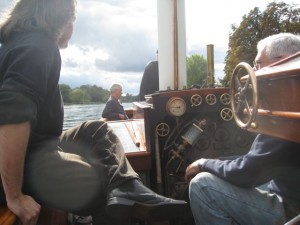 I got chatting to Tony Cundick holding court in his comfy looking director’s style chair also enjoying the scent of steam and who had really been the driving force behind restoring this old ship. There was nothing he didn’t know about her or many of the other steam survivors on the Thames. Consuta was commissioned from the Sam Saunders in 1898, an already renowned and successful Goring boat builder by a certain H.S. Clutton of Cleeve Mill to be used as an umpire launch for the Henley Royal Regatta. Anyway Mr Saunders had just developed, and been granted a patent for, Consuta Ply, a waterproof plywood before the advent of waterproof glues so Consuta (Latin for sewn together) became the first monocoque boat design the ply being four veneers of mahogany with calico soaked in linseed between them then laced together with copper wire.
I got chatting to Tony Cundick holding court in his comfy looking director’s style chair also enjoying the scent of steam and who had really been the driving force behind restoring this old ship. There was nothing he didn’t know about her or many of the other steam survivors on the Thames. Consuta was commissioned from the Sam Saunders in 1898, an already renowned and successful Goring boat builder by a certain H.S. Clutton of Cleeve Mill to be used as an umpire launch for the Henley Royal Regatta. Anyway Mr Saunders had just developed, and been granted a patent for, Consuta Ply, a waterproof plywood before the advent of waterproof glues so Consuta (Latin for sewn together) became the first monocoque boat design the ply being four veneers of mahogany with calico soaked in linseed between them then laced together with copper wire. 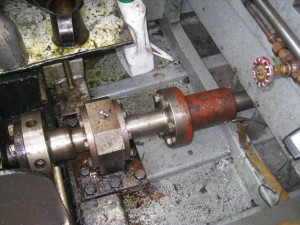 The hull is stiffened by longitudinal stringers rather than the traditional ribs, all tied together by the seat framework that runs the complete length down each side. Apparently, once completed, Saunders supported each end on trestles to demonstrate how strong this method of construction was. Now Sam Saunders is a bit of a hero of mine, a boat builder of some renown who later moved to the Isle of Wight and teamed up with the aviator A.V.Roe to form Saunders and Roe. Like another hero of mine old Pobjoy, Saunders’ name is sadly overlooked which is a shame as he was a very clever engineer.
The hull is stiffened by longitudinal stringers rather than the traditional ribs, all tied together by the seat framework that runs the complete length down each side. Apparently, once completed, Saunders supported each end on trestles to demonstrate how strong this method of construction was. Now Sam Saunders is a bit of a hero of mine, a boat builder of some renown who later moved to the Isle of Wight and teamed up with the aviator A.V.Roe to form Saunders and Roe. Like another hero of mine old Pobjoy, Saunders’ name is sadly overlooked which is a shame as he was a very clever engineer. 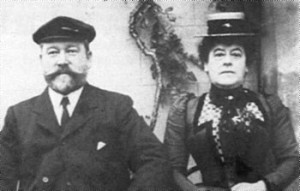 Sam Saunders was born in The Swan, Streatley in 1857 and started building boats at the pub in his teens. Despite his age he realised the potential market for Thames boats of every type, from college barges to racing skiffs, and soon became very successful. Many of his boats still survive today. Consuta Ply was soon being widely used in the hull construction of flying boats and airship gondolas so it was inevitable that the two would eventually team up. He died in 1933 but his legacy lived on in the Saunders-Roe name who in later years produced amongst others, the first flying boat designed as a jet-powered fighter, the hovercraft, the Tiger Coach and even the Black Night rocket. Consuta Ply itself was still being used into the sixties, not bad for a inn-keeper’s son from Streatley?
Sam Saunders was born in The Swan, Streatley in 1857 and started building boats at the pub in his teens. Despite his age he realised the potential market for Thames boats of every type, from college barges to racing skiffs, and soon became very successful. Many of his boats still survive today. Consuta Ply was soon being widely used in the hull construction of flying boats and airship gondolas so it was inevitable that the two would eventually team up. He died in 1933 but his legacy lived on in the Saunders-Roe name who in later years produced amongst others, the first flying boat designed as a jet-powered fighter, the hovercraft, the Tiger Coach and even the Black Night rocket. Consuta Ply itself was still being used into the sixties, not bad for a inn-keeper’s son from Streatley?
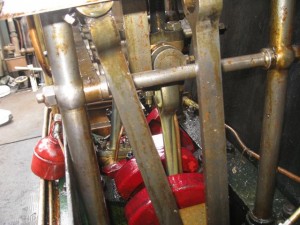 We slipped straight into Mapledurham Lock, reversing the engine which stopped the launch abruptly and the crew got to it stoking the fire and oiling up. Soon we were steaming purposely down the past Tilehurst on the outskirts of Reading, past the site of Little John’s Farm where I arrived early one morning in a balloon just ahead of the Reading Festival. Opening the damper up a tad chucked the odd smut out the funnel and you could here her yearning to work a bit harder but there are speed limits and eyes watching so care is needed. This is the only way to see the River it has to be said. A rowing event was taking place and a plastic skiff with an outrageous outboard shot past going the other way definitely on the hurry-up. Big frowns all round the river now sported a fine swell as its wake bounced from bank to bank. Tony explained that as the Consuta was so long getting the hang of steering her was tricky and did involve help from the engine. “Remember”, he said “When the crank isn’t turning nor will the prop and you’ll have no steerage. Being a steam engine of course the thing will turn over extremely slowly if you need it to, handy for getting into locks. Never rush manoeuvring her.” I wasn’t sure about having a crack at taking the helm but the engine, that was a different story.
We slipped straight into Mapledurham Lock, reversing the engine which stopped the launch abruptly and the crew got to it stoking the fire and oiling up. Soon we were steaming purposely down the past Tilehurst on the outskirts of Reading, past the site of Little John’s Farm where I arrived early one morning in a balloon just ahead of the Reading Festival. Opening the damper up a tad chucked the odd smut out the funnel and you could here her yearning to work a bit harder but there are speed limits and eyes watching so care is needed. This is the only way to see the River it has to be said. A rowing event was taking place and a plastic skiff with an outrageous outboard shot past going the other way definitely on the hurry-up. Big frowns all round the river now sported a fine swell as its wake bounced from bank to bank. Tony explained that as the Consuta was so long getting the hang of steering her was tricky and did involve help from the engine. “Remember”, he said “When the crank isn’t turning nor will the prop and you’ll have no steerage. Being a steam engine of course the thing will turn over extremely slowly if you need it to, handy for getting into locks. Never rush manoeuvring her.” I wasn’t sure about having a crack at taking the helm but the engine, that was a different story.
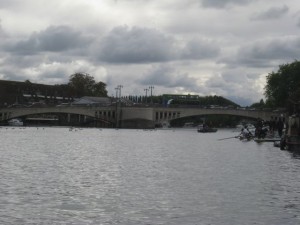 Caversham Bridge was passed, home of Radio Reading, as we always joke, and round the gentle curve into Caversham Lock and a crew change. By now there was a lot more going on and boats of every type were here and there some more knowledgeable than others in their rivercraft skills but the steam whistle soon got their attention. Brian Smith came astern and proferred a brew courtesy of the, mandatory I understand on steam boats, Windermere Kettle, a steam powered kettle. He explained that the Consuta had steamed until 1923 when the engine was replaced with a Wolseley petrol engine the Chertsey built DesVignes steam engine being used as a compressor plant driving a steel plate roller making cement mixer drums. Consuta carried on in her role as an umpire boat and in 1949 carrying TV cameras that gave the first live broadcast of the Henley Boat Race. She went on to provide the camera platform for the Oxford and Cambridge Boat race eventually being retired in the late sixties. When she was acquired by Graham Lindsay in 1975 with the intention of restoring her to her original glory she still had a load of TV related wiring and gear aboard!
Caversham Bridge was passed, home of Radio Reading, as we always joke, and round the gentle curve into Caversham Lock and a crew change. By now there was a lot more going on and boats of every type were here and there some more knowledgeable than others in their rivercraft skills but the steam whistle soon got their attention. Brian Smith came astern and proferred a brew courtesy of the, mandatory I understand on steam boats, Windermere Kettle, a steam powered kettle. He explained that the Consuta had steamed until 1923 when the engine was replaced with a Wolseley petrol engine the Chertsey built DesVignes steam engine being used as a compressor plant driving a steel plate roller making cement mixer drums. Consuta carried on in her role as an umpire boat and in 1949 carrying TV cameras that gave the first live broadcast of the Henley Boat Race. She went on to provide the camera platform for the Oxford and Cambridge Boat race eventually being retired in the late sixties. When she was acquired by Graham Lindsay in 1975 with the intention of restoring her to her original glory she still had a load of TV related wiring and gear aboard! 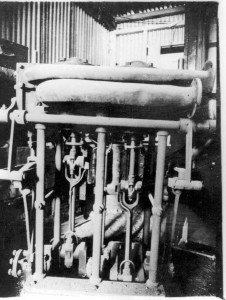 In an amazing quirk of fate it transpired that the steam engine he sourced to go back into Consuta bought from Tom Taylor’s boatyard at Staines in 1980 turned out to be the original that had been removed at Taylor Bates Chertsey yard all those years before. Restoring and keeping steam anything is extremely costly and time consuming so The Consuta Trust was formed in 1998 and funded the restoration programme eventually getting her back in the water in 2001 with the help of some additional and welcome Lottery Funding. Since then she has regularily attended events up and down the Thames and even went to Ely in 2004 to take part in the celebrations of the 1944 Oxford and Cambridge Boat Race which was held there and despite the freezing conditions managed to cover the 1.8 mile course in 6 minutes 18 seconds and recorded 17mph at 600rpm. David commented that when they opened her up, somewhat enthusiastically, the exhaust blast drew a fair bit of the fire up the funnel!
In an amazing quirk of fate it transpired that the steam engine he sourced to go back into Consuta bought from Tom Taylor’s boatyard at Staines in 1980 turned out to be the original that had been removed at Taylor Bates Chertsey yard all those years before. Restoring and keeping steam anything is extremely costly and time consuming so The Consuta Trust was formed in 1998 and funded the restoration programme eventually getting her back in the water in 2001 with the help of some additional and welcome Lottery Funding. Since then she has regularily attended events up and down the Thames and even went to Ely in 2004 to take part in the celebrations of the 1944 Oxford and Cambridge Boat Race which was held there and despite the freezing conditions managed to cover the 1.8 mile course in 6 minutes 18 seconds and recorded 17mph at 600rpm. David commented that when they opened her up, somewhat enthusiastically, the exhaust blast drew a fair bit of the fire up the funnel!
 Anyone that has sailed the Thames knows that waving is par for the course and when you are aboard a steam boat then it is doubly so. The engine quietly click-clacks in a nice audible soothing way but to those on the banks not a sound is heard as it hurries by just a nice trail of white smoke as the fire simmers nicely. There is then a compulsion to wave, so we did. All was well and then David asked if I fancied a go on the engine. “This is the main valve, turn it forwards to increase steam and back to slow. Make sure it gets locked back and that the engine has stopped before you unlock the reversing lever and move it up but only on command.” Brian’s son Paul explained. He maintains this wonderful bit of machinery and knows its foibles to a tee. He was also keeping an eye on the boiler which the previous stoker had somewhat over-coaled.
Anyone that has sailed the Thames knows that waving is par for the course and when you are aboard a steam boat then it is doubly so. The engine quietly click-clacks in a nice audible soothing way but to those on the banks not a sound is heard as it hurries by just a nice trail of white smoke as the fire simmers nicely. There is then a compulsion to wave, so we did. All was well and then David asked if I fancied a go on the engine. “This is the main valve, turn it forwards to increase steam and back to slow. Make sure it gets locked back and that the engine has stopped before you unlock the reversing lever and move it up but only on command.” Brian’s son Paul explained. He maintains this wonderful bit of machinery and knows its foibles to a tee. He was also keeping an eye on the boiler which the previous stoker had somewhat over-coaled. 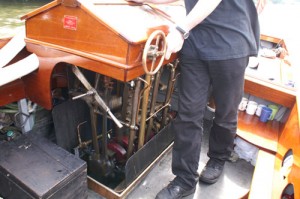 Sonning Lock approached “Astern please” was called as we crept in. I shut off the steam, checked the crank to see it had stopped and engaged reverse and opened the valve a notch and with a surge of power we stopped instantly. Now quickly shut the steam off again and re-engage forward and lock the lever back down. I hadn’t hit the lock gates. This was brilliant. Quickly Paul showed me where to squirt the oil. Into the big ends, the cups on the conrods the reversing gear and the mains, check the levels in the auto lubes for the pistons, there is a lot to do. “Ahead please” called the helmsman, a final squirt of oil and we were off again. “Hear that tapping?” asked Paul, “Its water in the cylinders so open up the drain taps”. Suddenly with a slight hiss we were back to click-clacks.
Sonning Lock approached “Astern please” was called as we crept in. I shut off the steam, checked the crank to see it had stopped and engaged reverse and opened the valve a notch and with a surge of power we stopped instantly. Now quickly shut the steam off again and re-engage forward and lock the lever back down. I hadn’t hit the lock gates. This was brilliant. Quickly Paul showed me where to squirt the oil. Into the big ends, the cups on the conrods the reversing gear and the mains, check the levels in the auto lubes for the pistons, there is a lot to do. “Ahead please” called the helmsman, a final squirt of oil and we were off again. “Hear that tapping?” asked Paul, “Its water in the cylinders so open up the drain taps”. Suddenly with a slight hiss we were back to click-clacks.
Avoiding a random yatch we passed by Fort Yuri Geller with its mast covered in survellience cameras and his bent railway track sculture on the bank, slowed for the blue-hulled Environment Boat and smiled politely then slowed and briefly came alongside a supporter for a quick chat then it was Shiplake Lock and more oiling. Tony rose from his rather comfy chair and took the helm, Paul had a read from his ‘I never knew that about the River Thames’ by Christopher Winn, a fine guide to the River strictly from the River. 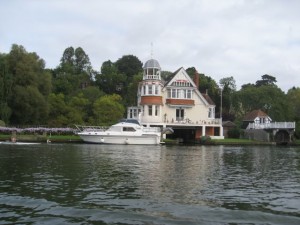 We simmered past Wargrave discovering that it was the former home of Raymond Baxter, Richard Morley and Dave Allen and now current home to Paul Daniels whose house, Winn told us, ‘is frequently flooded out’. “I think we might go a little faster”, suggested Tony all smiles and beard. I opened the steam valve a tad more and Consuta obligingly threw some more smoke over the stern and we hurried along, she was approaching home waters.
We simmered past Wargrave discovering that it was the former home of Raymond Baxter, Richard Morley and Dave Allen and now current home to Paul Daniels whose house, Winn told us, ‘is frequently flooded out’. “I think we might go a little faster”, suggested Tony all smiles and beard. I opened the steam valve a tad more and Consuta obligingly threw some more smoke over the stern and we hurried along, she was approaching home waters. 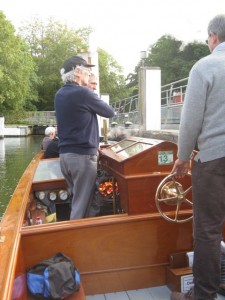 There does seem a necessity to stand when aboard this lovely ship, no idea why but we did mainly standing in the stern but the crew in the bows seemed content sitting and chatting. That is about the only drawback with having an engine room in the middle but one could still converse. No rattling diesel to have to shout over. Most appropriately we slid past Humphrey Gainsborough’s house on the outskirts of Henley. Now he was the brother of the painter and a religious man but a keen engineer to boot. Not only had he built most of the locks we’d navigated but he also designed and built a small steam engine complete with condenser which he rather carelessly showed to his mate James Watt who shot off and patented his version in 1769. So there we were passing the home of the man who invented the steam engine in a launch powered by one. We gave him a salute.
There does seem a necessity to stand when aboard this lovely ship, no idea why but we did mainly standing in the stern but the crew in the bows seemed content sitting and chatting. That is about the only drawback with having an engine room in the middle but one could still converse. No rattling diesel to have to shout over. Most appropriately we slid past Humphrey Gainsborough’s house on the outskirts of Henley. Now he was the brother of the painter and a religious man but a keen engineer to boot. Not only had he built most of the locks we’d navigated but he also designed and built a small steam engine complete with condenser which he rather carelessly showed to his mate James Watt who shot off and patented his version in 1769. So there we were passing the home of the man who invented the steam engine in a launch powered by one. We gave him a salute.
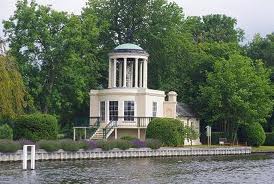 A quick straw poll was taken as we approached Henley Lock or, to be more correct as we were in Henley actually, Marsh Lock and its impressive footbridge as to whether we ought to have a charge past the Angel on the Bridge and then down and around Temple Island before coming up to the mooring set aside for us at Hobb’s Yard where the crane was already in place for the lift on Monday. Paul looked knowingly at the water level and the pressure, did a bit of dead reckoning and sat back. He was going to get us up and down the old course without any more fettling. It was decided there was no need for an oiling as we were running very light so it was in and out of the lock with the minimum of fuss. We passed under the gaze of Old Father Thames and entered the Racing Mile gently puffing through the twin portals of Remenham House and Fawley Court, Paul raked a lot of the ash out from the ash pan, Tony took us smartly round Temple Island by calling for full power of which there wasn’t much, and started back down the rowing course itself. Pressure was down to just under 50 psi the steam valve nearly fully open. The chief engineer had a quick look in the firebox and waited. We slid back under the bridge and lined up for the now ominously small looking space at the yard pressure down to less than 30. “I think perhaps shut her right back would be good,” suggested Tony, “Just keep her turning, be ready for reverse”. Then that was it, with hardly a whisper of pressure we effected a stop and pulled into what was a very tight mooring. The fire had gone out and the water was just out of the gauges. Perfect judgement I reckoned.
A quick straw poll was taken as we approached Henley Lock or, to be more correct as we were in Henley actually, Marsh Lock and its impressive footbridge as to whether we ought to have a charge past the Angel on the Bridge and then down and around Temple Island before coming up to the mooring set aside for us at Hobb’s Yard where the crane was already in place for the lift on Monday. Paul looked knowingly at the water level and the pressure, did a bit of dead reckoning and sat back. He was going to get us up and down the old course without any more fettling. It was decided there was no need for an oiling as we were running very light so it was in and out of the lock with the minimum of fuss. We passed under the gaze of Old Father Thames and entered the Racing Mile gently puffing through the twin portals of Remenham House and Fawley Court, Paul raked a lot of the ash out from the ash pan, Tony took us smartly round Temple Island by calling for full power of which there wasn’t much, and started back down the rowing course itself. Pressure was down to just under 50 psi the steam valve nearly fully open. The chief engineer had a quick look in the firebox and waited. We slid back under the bridge and lined up for the now ominously small looking space at the yard pressure down to less than 30. “I think perhaps shut her right back would be good,” suggested Tony, “Just keep her turning, be ready for reverse”. Then that was it, with hardly a whisper of pressure we effected a stop and pulled into what was a very tight mooring. The fire had gone out and the water was just out of the gauges. Perfect judgement I reckoned. 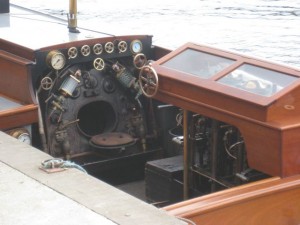 Now the last of the pressure was let go and the last of the steam accompanied by deep rumblings and clonkings was let go then suddenly it was quiet. Consuta had been put to bed until next year. On Monday the crane would first lift out the boiler and then Consuta herself would be craned out, loaded up and taken off to Henwood and Deans yard for a makeover whilst the boiler got some well deserved tlc.
Now the last of the pressure was let go and the last of the steam accompanied by deep rumblings and clonkings was let go then suddenly it was quiet. Consuta had been put to bed until next year. On Monday the crane would first lift out the boiler and then Consuta herself would be craned out, loaded up and taken off to Henwood and Deans yard for a makeover whilst the boiler got some well deserved tlc.
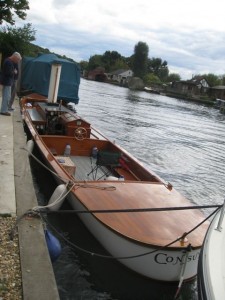 Farewells were made, Paul kindly pointing out the effect of smuts to my face, and we headed back to pick up cars at Beale Park coming in via Goring as the Whitchurch Bridge was closed and passing Saunders original showroom and yard, now bedecked with a Blue Plaque, Consuta was built back in 1898. David explained that when Sam Saunders moved down to the Isle of Wight he sold his yards and properties to Hobbs of Henley. How appropriate then I thought.
Farewells were made, Paul kindly pointing out the effect of smuts to my face, and we headed back to pick up cars at Beale Park coming in via Goring as the Whitchurch Bridge was closed and passing Saunders original showroom and yard, now bedecked with a Blue Plaque, Consuta was built back in 1898. David explained that when Sam Saunders moved down to the Isle of Wight he sold his yards and properties to Hobbs of Henley. How appropriate then I thought.
http://www.consuta.org.uk The site of the Consuta Trust with loads of stuff on it including David Eagers plans for the boiler (offers of funding greatly accepted).
http://www.youtube.com/watch?v=rC57czTH9f4. Consuta at the Twickenham Races
http://www.youtube.com/watch?v=_nujwQHcTi4 At the 2002 Henley Races re-instated as an Umpires launch.